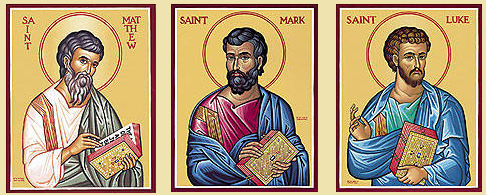
WelCom April 2022
The following article by Br Kieran Fenn fms is a presentation of why the Scriptures were written and the context in which they were written.
From the Old

It is an obvious fact that the Gospels differ. Why is Luke’s Good Shepherd (15:3-7) obviously Jesus while Matthew’s (18:10-14) is the struggling pastor? Why does Mark’s Gerasene demoniac (5:1-20) suddenly become two of them in Matthew (8:28-9:1)? And the crucifixion in John, it takes place the day before it does in the other three. I think I could give more differences than the village atheist could. It took the Catholic Church a long time to face the question raised by biblical interpretation and stop silencing those who raised the difficult questions, everybody from Richard Simon who saw that Moses could not have written the whole of the first five books of the Bible, including the account of his own death, to JM Lagrange, founder of the Ecole Biblique*, who also raised the awkward question that Isaiah of Jerusalem could not have composed a book that covered hundreds of years. The response of the pope of the time was to order Lagrange into the ‘less dangerous’ field of the New Testament in which he did great work.
Protestant scholarship thrived and Catholic scholarship owes a huge debt to the best of it in times then and now. As a Catholic scholar who has had the good fortune to teach in a number of Protestant learning centres, I know we have more that unites us than divides us. Into our vacuum stepped Cardinal Bea and Pope Pius XII with Divino Afflante Spiritu, the 1943 Magna Carta of Biblical Studies in Catholicism, # 35. What is the literal sense of a passage is not always as obvious in the speeches and writings of the ancient authors of the East, as it is in the works of our own time. For what they wished to express is not to be determined by the rules of grammar and philology alone, nor solely by the context; the interpreter must, as it were, go back wholly in spirit to those remote centuries of the East and with the aid of history, archaeology, ethnology, and other sciences, accurately determine what modes of writing, so to speak, the authors of that ancient period would be likely to use, and in fact did use.
To the New

But then, what of the New Testament, and the Gospels in particular? They are different in their choice of events, emphases, and order. Did Jesus cleanse the Temple at the beginning of his ministry (John) or at the end (Synoptic Gospels)? The order and differences are to serve theological interests rather than biographical ones. The Pontifical Biblical Commission, our highest Biblical authority, faced the challenges presented in the composition of the Gospels with its ‘Instruction of the Historical Truth of the Gospels’ (1964) {vi and x}. ‘To judge properly concerning the reliability of what is transmitted in the Gospels, the interpreter should pay diligent attention to the three stages of tradition by which the doctrines and life of Jesus has come down to us. Pay attention to what pertains to the origin and composition of the Gospels and make proper use of all the praiseworthy attempts of recent research to fulfil the task of seeking out what the sacred writers intended and what they really said.
Stage One is the life of the historical Jesus, which provided his ministry and teaching, his death and resurrection. Stage Two is the time span of forty to sixty years of the oral tradition that saw the telling of the Jesus story; while details can change the essential meaning remains. Stage Three is the time of the writing of the Gospels, the shaping of the Jesus story for the needs of the community the evangelist is writing. That we need to know, in order to apply it to our own community needs. That explains why in the Gospel of the Church, Matthew, the Good Shepherd becomes the Pastor who goes out to seek the strayed sheep and if he finds it there is rejoicing. As well, the parable is part of the great discourse on life and leadership in the church community of ch. 18.
When the early community gathered after the Passion, Death and Resurrection, clearly they would have talked about what has just happened. The first part of the Gospel to take form was the narrative of the Passion with some Resurrection appearances. This was all the Jesus story that Paul knew in the earliest part of the New Testament, the Epistles. Then the question arose as to what Jesus did to get himself crucified, the ministry of Jesus, the second part, and this we see in Mark who put the two pieces together around the year 70. I like to think of a mother in the Christian community asking, ‘What was he like as a child?’ and the resulting Infancy Narratives of Matthew and Luke, the third level that came into being. But note something significant from this – the Gospels as we read them are in the reverse order to the way they came into being. The truth is, out of Easter came the Gospels.
Stage One is the life of the historical Jesus, which provided his ministry and teaching,
his death and resurrection. Stage Two is the time span of forty to sixty years of the oral
tradition that saw the telling of the Jesus story; while details can change the essential
meaning remains. Stage Three is the time of the writing of the Gospels, the shaping of
the Jesus story for the needs of the community the evangelist is writing.”
As for our other puzzles, Matthew likes doubling up; often one leper becomes two; one blind man such as in the Bartimaeus account of Mark becomes two in Matthew. Perhaps it was because in Jewish law two witnesses were required. It might even be if one is good, two is better! And John’s Gospel introduced Jesus as the Lamb of God (1:29-34) so he dies as the new Lamb of God at the time the Passover Lambs are being sacrificed (19:31,42). Hence the meal in John is not a Passover meal but a Farewell meal with the Passover Lamb to be. This is a good lesson for us; we do not ask who is correct? We ask what does it mean within the context of its own Gospel.
Kieran Fenn’s article, written for the Autumn issue of the Methodist quarterly, Word and Worship, has been republished in WelCom with permission. Kieran, a scholar with expertise on the Word of God, has spent several years in Adult Education teaching Scripture in New Zealand and abroad.
[*Br Marie-Joseph Lagrange, a professor of Church history and Holy Scripture, founded Ecole Biblique in Jerusalem in 1890, as a centre of biblical research and teaching, attached to a community of Dominican friars.]